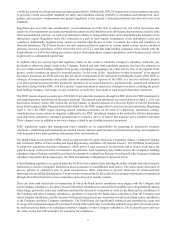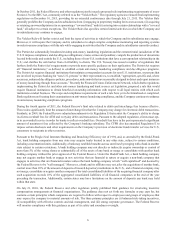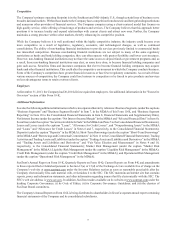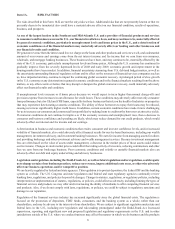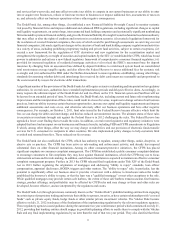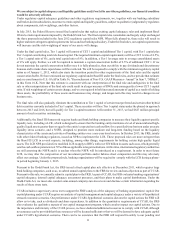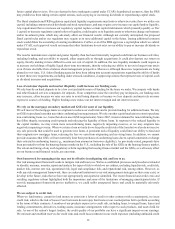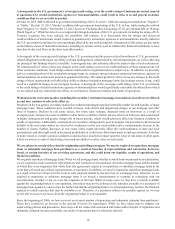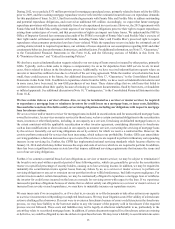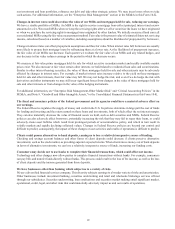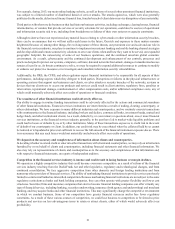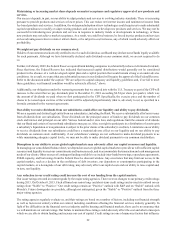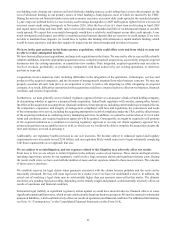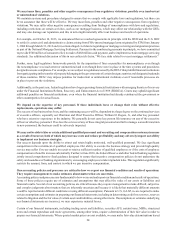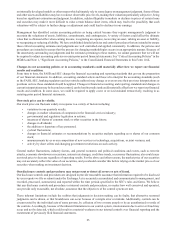SunTrust 2013 Annual Report Download - page 31
Download and view the complete annual report
Please find page 31 of the 2013 SunTrust annual report below. You can navigate through the pages in the report by either clicking on the pages listed below, or by using the keyword search tool below to find specific information within the annual report.15
During 2012, we recorded a $371 million provision for mortgage repurchase losses, primarily related to loans sold to the GSEs
prior to 2009, and the resulting mortgage repurchase reserve reflected the estimated incurred losses on repurchase demands
for this population of loans. In 2013, SunTrust reached agreements with Fannie Mae and Freddie Mac to address outstanding
and potential repurchase obligations, and reserved an additional $63 million. Accordingly, we expect that future mortgage
repurchase provisions will decrease substantially from levels experienced in recent years. However, the 2013 agreements with
Fannie Mae and Freddie Mac settling certain aspects of our repurchase obligations preserve their right to require repurchases
arising from certain types of events, and that preservation of rights can impact our future losses. We understand the FHFA’s
Office of Inspector General has commenced an audit of the FHFA’s oversight of Fannie Mae’s and Freddie Mac’s exercise of
their rights under settlement agreements with banks, including Fannie Mae’s and Freddie Mac’s preserved right to require
repurchases when consumer protection laws have been violated. While the repurchase reserve includes the estimated cost of
settling claims related to required repurchases, our estimate of losses depends on our assumptions regarding GSE and other
counterparty behavior, loan performance, home prices, and other factors. For additional information, see Note 17, “Guarantees,”
to the Consolidated Financial Statements in this Form 10-K, and the following sections of MD&A in this Form 10-
K-"Noninterest Income” and "Critical Accounting Policies."
We also have received indemnification requests related to our servicing of loans owned or insured by other parties, primarily
GSEs. Typically, such a claim seeks to impose a compensatory fee on us for departures from GSE service levels. In most
cases, this is related to delays in the foreclosure process. Additionally, we have received indemnification requests where an
investor or insurer has suffered a loss due to a breach of the servicing agreement. While the number of such claims has been
small, these could increase in the future. See additional discussion in Note 17, “Guarantees,” to the Consolidated Financial
Statements in this Form 10-K. In addition to repurchase claims from the GSEs, we have received indemnification claims and
in some cases, have been sued, by non-GSE purchasers of our loans. These claims allege that we sold loans that failed to
conform to statements about their quality because of missing or inaccurate documentation, fraud by borrowers, or fraudulent
or inflated appraisals. See additional discussion in Note 19, “Contingencies,” to the Consolidated Financial Statements in this
Form 10-K.
We face certain risks as a servicer of loans. Also, we may be terminated as a servicer or master servicer, be required
to repurchase a mortgage loan or reimburse investors for credit losses on a mortgage loan, or incur costs, liabilities,
fines and other sanctions if we fail to satisfy our servicing obligations, including our obligations with respect to mortgage
loan foreclosure actions.
We act as servicer and/or master servicer for mortgage loans included in securitizations and for unsecuritized mortgage loans
owned by investors. As a servicer or master servicer for those loans, we have certain contractual obligations to the securitization
trusts, investors or other third parties, including, in our capacity as a servicer, foreclosing on defaulted mortgage loans or, to
the extent consistent with the applicable securitization or other investor agreement, considering alternatives to foreclosure
such as loan modifications or short sales and, in our capacity as a master servicer, overseeing the servicing of mortgage loans
by the servicer. Generally, our servicing obligations are set by contract, for which we receive a contractual fee. However, the
costs to perform contracted-for services has been increasing, which reduces our profitability. Further, GSEs can amend their
servicing guidelines, which can increase the scope or costs of the services we are required to perform without any corresponding
increase in our servicing fee. Further, the CFPB has implemented national servicing standards which became effective on
January 10, 2014 and which may further increase the scope and costs of services which we are required to perform. In addition,
there has been a significant increase in state laws that impose additional servicing requirements that increase the scope and
cost of our servicing obligations.
Further, if we commit a material breach of our obligations as servicer or master servicer, we may be subject to termination if
the breach is not cured within a specified period of time following notice, which can generally be given by the securitization
trustee or a specified percentage of security holders, causing us to lose servicing income. In addition, we may be required to
indemnify the securitization trustee against losses from any failure by us, as a servicer or master servicer, to perform our
servicing obligations or any act or omission on our part that involves willful misfeasance, bad faith or gross negligence. For
certain investors and/or certain transactions, we may be contractually obligated to repurchase a mortgage loan or reimburse
the investor for credit losses incurred on the loan as a remedy for servicing errors with respect to the loan. If we experience
increased repurchase obligations because of claims that we did not satisfy our obligations as a servicer or master servicer, or
increased loss severity on such repurchases, we may have to materially increase our repurchase reserve.
We may incur costs if we are required to, or if we elect to, re-execute or re-file documents or take other action in our capacity
as a servicer in connection with pending or completed foreclosures. We may incur litigation costs if the validity of a foreclosure
action is challenged by a borrower. If a court were to overturn a foreclosure because of errors or deficiencies in the foreclosure
process, we may have liability to the borrower and/or to any title insurer of the property sold in foreclosure if the required
process was not followed. These costs and liabilities may not be legally or otherwise reimbursable to us, particularly to the
extent they relate to securitized mortgage loans. In addition, if certain documents required for a foreclosure action are missing
or defective, we could be obligated to cure the defect or repurchase the loan. We may incur a liability to securitization investors


